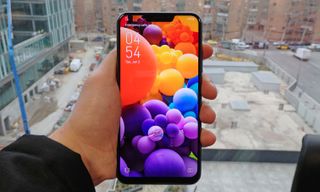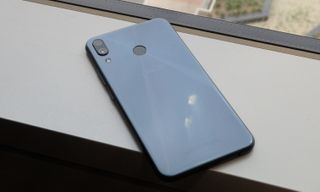Asus ZenFone 5 Is a Cheaper iPhone X with a Bigger Screen
Asus has disguised its latest mid-range Android phone as an iPhone X, but that's where the similarities end.
BARCELONA — It was only a matter of time before an Android manufacturer adapted the iPhone X’s notch for its own. And despite rumors earlier this year that Motorola would be first out of the gate, it turns out Asus had its own plans.

Yes, consider Asus’ ZenFone 5 the first handset — at least, from a major phone maker — to imitate Cupertino’s design statement. And the ZenFone 5’s notch isn’t a small nub for the camera, as you’ll find on the Essential Phone. It’s a full-on rectangular protrusion that is unmistakably reminiscent of Apple's flagship. Look for the ZenFone 5, notch and all to ship in April.

That said, there’s more to the ZenFone 5 than its notch. Asus is focusing on three main areas for its latest mainline phone: the display, the camera, and a suite of smart features. And to be clear, this device is not to be confused with the range-topping ZenFone 5Z, which serves as the flagship for the brand, and is mostly similar to the ZenFone 5 but features a more powerful processor.
The mid-range ZenFone 5 comes equipped with a 6.2-inch LCD panel with a 19:9 aspect ratio and resolution beyond full HD. That's even wider than what you get from most phones, which fall in the 18:9 range. And despite the fact that the screen doesn’t utilize OLED technology, Asus is proud of its color reproduction, saying it fulfills 100 percent of the DCI-P3 color range, which has a bit more life to it than traditional sRGB but not so much as to be oversaturated.

However, the dual camera is the area where Asus lavished the most attention. Unlike many phones that pull off portrait mode using a telephoto lens in tandem with a standard one, the ZenFone 5 employs a wide-angle lens. There are phones with wide-angle secondary lenses, like LG’s G6 and V30, but they tend to shy away from bokeh, simply because the nature of the perspective doesn’t create the same shallow depth-of-field effect that pulls the background in, which is a hallmark of professional portraits.
Asus readily admits that there are downsides to this approach, but it also knows its customers love the versatility of wide angle for landscapes, which is why it opted to keep one here. The main sensor is rated at 12 megapixels, with an aperture of f/1.8, while the secondary one is 6 MP and has a slightly smaller aperture of f/2.2.

Beyond portraits and stunning landscapes, Asus is confident the ZenFone 5 can perform much better in low light situations, thanks not only to that wider f/1.8 aperture but also the company’s AI software. Much like what we’ve seen from the Huawei Mate 10 Pro, Honor 7X and the just-announced LG V30S ThinQ, the ZenFone 5 can identify an assortment of stimuli, including people, dogs, food, sunsets and so on, and adjust the shot on the fly to deliver the best possible result suited to that particular scene.
The cameras’ use of AI ties into another aspect of the ZenFone 5 that Asus is pushing hard with its newest devices. There are a handful of “smart” software features inside the phone maker’s latest interface, Zen UI 5, that aim to optimize performance by monitoring usage patterns. Unlike the camera, there’s no machine learning at work here, though these additions could still be useful.
One feature, for example, boosts processor performance when it’s absolutely necessary. According to Asus, in these situations the Snapdragon 636 chipset inside the ZenFone 5 will actually behave more like the more powerful Snapdragon 660. Another new mode recognizes if you typically plug your phone in when you go to bed, and avoids putting undue stress on the battery by maintaining an 80 percent charge through the night. Over time, once the phone learns when you typically wake up, it’ll make sure the battery reaches 100 percent only just before you start the day, which theoretically should help against degradation.
There are loads more changes packed into the ZenFone 5, like stereo speakers that are significantly louder than the outgoing model's. Those speakers support DTS 7.1 virtual surround sound. Although the peak volume certainly seems to have been increased, the sound itself did come across a bit too muffled and imprecise when Asus demoed it against a Pixel 2.
The real test for the ZenFone 5 will come once we’re able to evaluate its camera and smart software in real-world situations. We're also waiting to hear a price tag for this new phone.

Asus is also working on a lower-priced model called the ZenFone 5Q, which will be known as the ZenFone 5 Lite outside of the U.S. Due out in March, it has a 6-inch 18:9 display (sans notch) and a pair of front-facing cameras as well as downgrades to the rear lenses and processor. Look forward to a full review of Asus’ latest devices once they're released.
Photo Credit: Adam Ismail/Tom's Guide
Sign up to get the BEST of Tom’s Guide direct to your inbox.
Upgrade your life with a daily dose of the biggest tech news, lifestyle hacks and our curated analysis. Be the first to know about cutting-edge gadgets and the hottest deals.
Adam Ismail is a staff writer at Jalopnik and previously worked on Tom's Guide covering smartphones, car tech and gaming. His love for all things mobile began with the original Motorola Droid; since then he’s owned a variety of Android and iOS-powered handsets, refusing to stay loyal to one platform. His work has also appeared on Digital Trends and GTPlanet. When he’s not fiddling with the latest devices, he’s at an indie pop show, recording a podcast or playing Sega Dreamcast.
